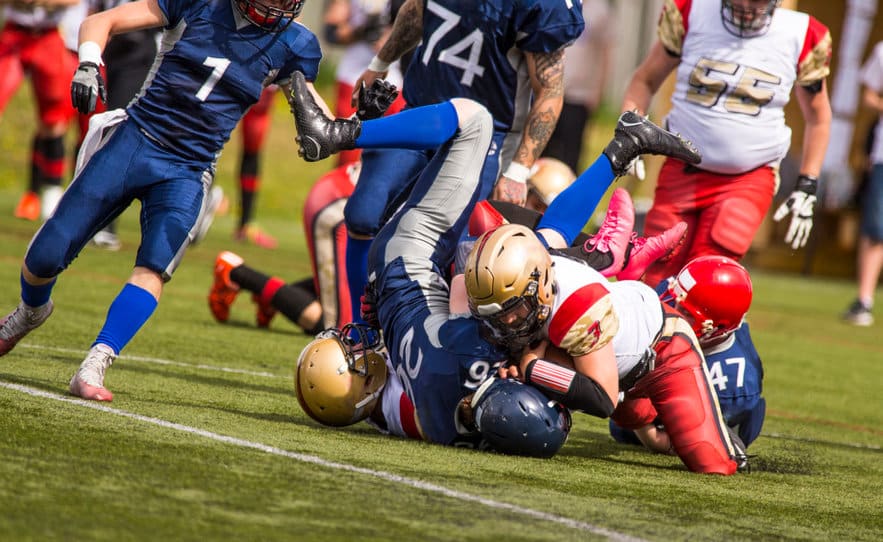By John Salak –
January is definitely a time to celebrate the most popular sport in America: football. The Division 1 college playoffs take center stage, and the NFL playoffs gear up for the culmination of the season that comes in early February with the Super Bowl. Even casual fans or TV by-passers take note. And why not. These are great high-stakes games played by world-class athletes.
Sadly, the steep price paid by these athletes is becoming increasingly clear. The long-term physical and mental health implications for dedicated athletes can result in energy loss, inflammation, coordination and balance issues and even cognitive decline. More importantly, these problems can impact anyone who plays the game over time, not just NFL stars or top-tier college players.
Certainly not every football player is impacted negatively. Beyond this, virtually every level of football from programs for adolescents through college players and professionals is increasingly aware of the risks and is taking steps to mitigate the dangers. But risks still exist.
Just-released research out of Northwestern Medicine, Pennsylvania State University and other collaborating universities, for example, claim college footballers with more than a decade of experience, which is about all of them, suffer from related abnormalities in inflammation, energy production and coordination. These problems don’t just begin and end with the football season. They are long-term. 
The problems stem from related to routine repetitive head impacts that come from tackling and blocking, which isn’t a surprise to those who follow the issue. This recent research, however, took a different approach. Previous studies generally focused on an injury’s ability to cause a clinical concussion. The combined team worked instead to assess the routine effect of repeated tackles or blows to the head over a season.
Ultimately, the research found that that impact sport athletes, such as footballers, have chronic problems regardless of their history of concussions. Issues were found by measuring abnormal regulation of inflammation, less coordinated movement and abnormalities in how cells produce energy. “These findings support over a decade of reports about the negative effects of repetitive head impacts along with studies of animal brain injury,” said co-senior author Dr. Hans Breiter, professor of psychiatry and behavioral sciences at Northwestern University Feinberg School of Medicine. “At this point, it appears the canary is dead in the coal mine.”
“This problem affects much of youth and professional impact sports in the U.S., along with training of U.S. military personnel,” added co-senior author Dr. Semyon Slobounov, professor of neurosurgery at Penn State College of Medicine. “A lack of energy can have significant consequences, especially in regard to brain function, raising questions of the long-term consequences,” co-lead author Sumra Bari contributed.
The research needs to be expanded not only to find the causes, but ways to deal with the problem, the team advised. “Ultimately, the goal is to develop preventative interventions that minimize abnormal changes in the brain that have been observed in studies of contact sport athletes time and time again,” said lead author Nicole Vike. “Collectively, we need to use interdisciplinary approaches, like those used here, to better quantify the unseen damage of contact sports.”
Identifying potential health problems related to contact sports isn’t new or surprising. At nearly the same time the research on college football players was released, another study warned that professional football players in the NFL are four times more likely to develop and die from amyotrophic lateral sclerosis (ALS) than all others. ALS is a motor neuron disease that often leads to rapidly progressing disability and death.
The impact, of course, isn’t limited to just professional athletes. The results suggested that the risk of ALS grew the longer someone played. Contact again was the issue. Anyone suffering from repeated blows to the head from football and other contact sports are known to have a higher risk of death due to dementia and neurodegenerative diseases like ALS, the study noted.
“We now have additional evidence that repetitive head impacts or concussions might increase risk of ALS,” explained Daniel Daneshvar, M.D., Ph.D., a professor at Harvard and the study’s co-author. “Your brain doesn’t care what hits it. You could have exposure to repetitive head impacts from sport, military service, occupation, domestic violence or any other cause, and any of these exposures might be related to ALS risk.”
Parents of children playing contact sports should be aware of the risks, noted Dr. Robert Glatter, who was not directly involved in this study. “Parents should recognize that the risk for neurodegenerative diseases including ALS and CTE increases with the number of years spent playing,” he noted.
Sadly, repeated head hits can also lead to brain injuries that might not be seen in the short term but can contribute to an early advanced stage of dementia. In the past, the related consequences may not become apparent until after a person died and an autopsy was performed.
Yet another recent study suggests brain scans might be able to spot trouble from sports-inflicted damage while a person is alive. “A routine scan might be able to capture long-term harm to the brain in people who have been exposed to repetitive hits to the head, like those from American football and other contact sports,” reported Michael Alosco, the study’s author and co-director of Boston University’s Alzheimer research center. “They literally appear as bright white spots,” said Alosco. “Anyone can see them. And they signal injury to the white matter of the brain.”
Football remains a great game, one that is making strides to reduce the long-term health issues for those who participate. Early detection is obviously a potential gateway to early treatment of mental and physical problems that can lessen their impact.












